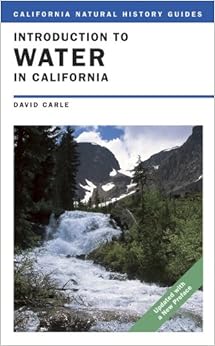Written
by David Carle, ”Introduction to Water in California” is a book that was
written to educate the public and bring to light the pressure issues regarding
water rights and availability in California. The book spends its first few
chapters highlighting the decorated history of California, from its early
Native American residents and natural splendor, establishment of towns and
cities during the California Gold Rush, and into the sprawling metropolis and
agricultural center the state is today. The author used maps and diagrams to
give the reader a sense of how large California is and the various climatic
conditions present which would affect the amount of yearly precipitation in
varying parts of the state. This data gives the reader an idea of why there is
so much water being pumped to different parts of the state, the central valley
area for example, receives 5-10” of rain per year yet is one of the primary
crop production sites in the world. That minute amount of precipitation doesn’t
satisfy the needs of all that agricultural land, millions and millions of
gallons of water pumped from sources hundreds of miles away does.
Californians
have always had water issues, to satisfy the needs of the state, dams were
built along rivers to create reservoirs to store water so that more would be
available each year. As time went on, the demand continually increased and the
number of dams increased. Eventually we reach present day were only a handful
of rivers or streams remain free-flowing, and many of the rivers that do have
dams have more than one. All of these dams essentially chocked the river
systems, showing a dramatic decrease in flow rate and water levels year after
year. Some waterways are only a fraction of what they were less than a hundred
years ago, others have completely dried out and which has led to dust storms
plaguing nearby residents. Entire ecosystems have been altered dramatically and
possibly irreversibly in some areas. While sparse in precipitation, the central
valley used to boast over 500,000 acres of wetlands due to snow melt run-off
from streams, but due to dams and water mitigation, less that 0.01% of that
wetland still exists. (Carle 71) Wildlife populations have suffered dramatic
losses due to such changes. Several species of salmon have become endangered
due to the dams and constricted water ways. The salmon are no longer able to
make it up the river to their spawning grounds and the few that do risk being
caught in the dams’ turbines. Chemical and temperature changes in the water due
to interaction with the dam also throw off the homing instincts of the salmon
to where they are unable to recognize their home waters.
Much
of California’s wealth and prosperity could be traced to its agricultural
economy with markets stretching all over the globe. To keep up with an
international demand, crops must be grown year round, a majority of the
farmland being in the central valley area. With less than 10 inches of rainfall
annually, the central valley and other agricultural sites created huge
pressures on surrounding resources to ensure that the farmland has adequate
water supplies year-round. With agriculture being one of the main primary
causes for California’s water issues, the other is the ever increasing number
of people populating the state. Since the Gold Rush, California’s population
have bean growing exponentially. With this growth, the demand for water has
rapidly outpaced the supply, local aquifers have been depleted because they
could not recharge in time, hundreds of small streams lay barren because they
have been dammed and used for water storage. Currently, California is steadily
moving to a point of unsustainability and if immediate measures are not taken
to decrease water use and increase efficiency, the effects on the environment
and the state could be dramatic.
I
found this book to be quite interesting after re-reading it upon my return from
my month long trip out west. After personally seeing all of California,
observing how you could be traveling on a road in the southern part of the
state where one side of the road is barren fields and the other side is lush
and green farmland. My observations definitely gave me a better understanding
of the author’s message. Our group traveled through farmland and along the Los
Angeles Aqueduct, along roads with barren land on one side and lush farmland on
the other. We personally viewed how farmers continually flood their crops
knowing that it is a waste of water, but that there is no incentive to improve
efficiency because the farmer’s water rights would be reduced if they did.
Perhaps if a water banking system were implemented up to a maximum amount of
allotted water would entice some farmers to make the transition to more
efficient watering techniques. Our group was given a tour of the Moccasin Power
plant which takes water from Hetch Hetchy near Yosemite National Park and
distributes it to San Francisco. To ensure enough water is stored in case of
excessive need, the Hetch Hetchy, Lake Eleanor, Cherry Lake, and Don Pedro
reservoirs were established. We also saw just how much of an impact this years’
draught has had on the reservoirs and water supplies, seeing many small streams
completely dried up. We witnessed the over-pumping that has occurred in just
Lake Mead alone knowing that it is happening in dozens of other reservoirs that
supply water to the state. From my time in California, I think that the state
government needs to give individuals a reason to reduce their water
consumption, provide assistance for farmers to transition to more efficient
watering systems, and work on removing unnecessary dams to improve water flows
and supplies all while managing the human growth within the state.
Reference
Carle, David. Introduction
to Water in California. Berkeley: U of California, 2004. Print.

No comments:
Post a Comment